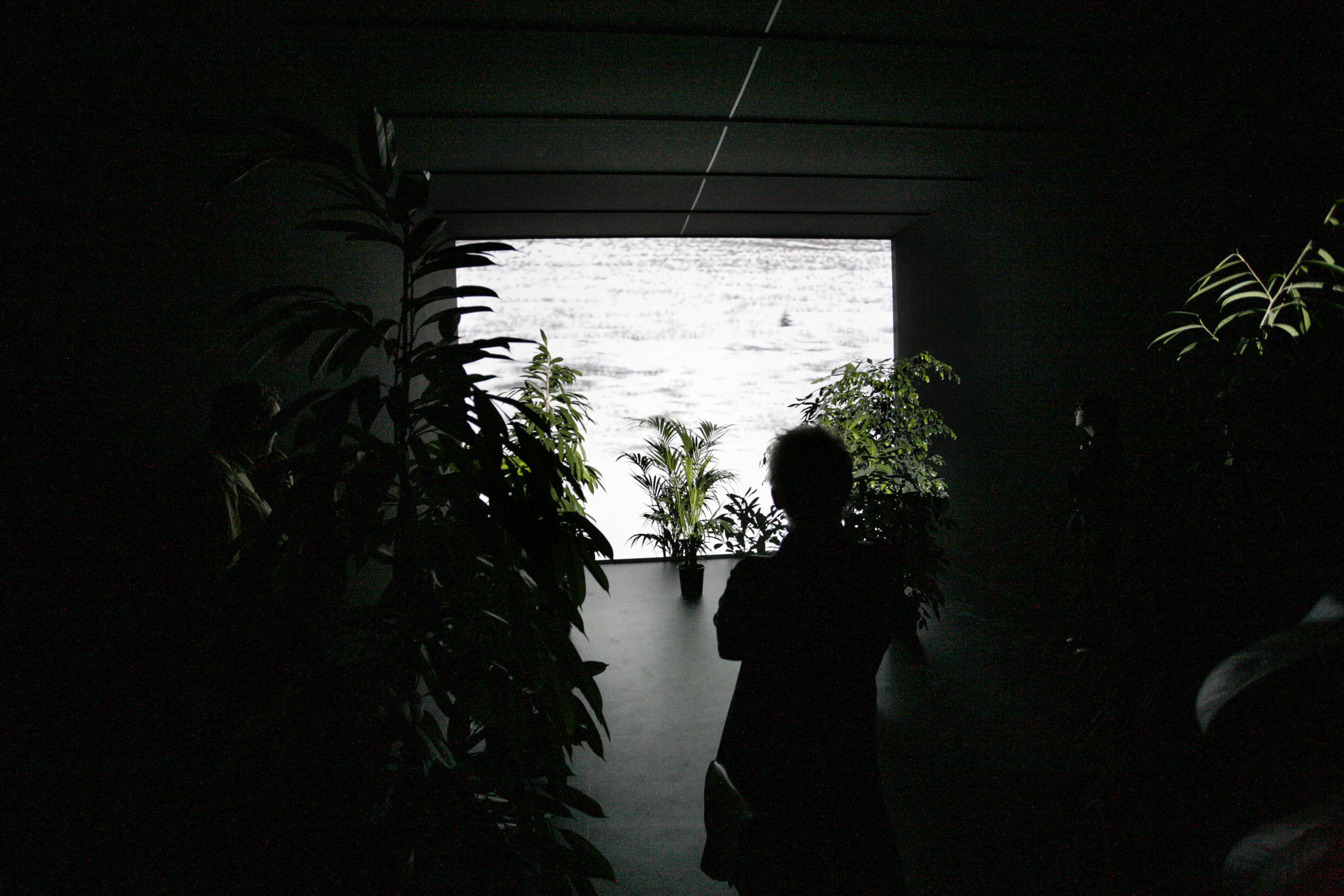
Suzana Marjanić
Institute of Ethnology and Folklore Research
Translated by Mirta Jurilj
Here, I would like to present reflections on and reactions to selected performances related to the recent refugee and humanitarian crises in Croatia (in 2015 and 2016). As the conductive black thread of the fragments presented in this paper — the links between racism and speciesism, and the links between the refugee crisis and speciesism — have been interpreted. These connections are documented by artistic and activist works (radical performances in the line of Baz Kershaw) in Croatia. The examples include Sanja Iveković; Ivan Mesek; D. B. Indoš and Tanja Vrvilo (House of Extreme Music Theatre); and Animal Friends Association from Croatia. I will also introduce the work by Franc Purg, a Slovenian artist based in London, in the context of work by Sanja Iveković.
In 2015, during arrangements for the distribution of Syrian refugees among the member states of the European Union, the government of Slovakia proclaimed that they would only accept Christians. That same year, Hungary put up a four-meter razor-wire fence along its 175-kilometer border with Serbia. Also in 2015, Slovenia put up a razor-wire fence along its border with Croatia; and finally, Croatia and its neighbouring countries officially closed the borders to refugees on 9 March 9 2016. This is a fragment of a broader context of the refugee crises at the Croatian-Slovenian and Croatian-Hungarian borders — the Western Balkan Route.
For the purpose of introduction, I shall interpret the works of feminist artist Sanja Iveković and multimedia artist Franc Purg who — each in their own respective artistic practises and, naturally, starting from their own respective ethea— have set in parallelism the question of forced migrations, refugee/humanitarian crisis, and speciesism (human discrimination toward other species — both plants and animals). Both works were exhibited and performed at the 51st Zagreb Salon of Visual Arts — Challenges to Humanism (2016), the first exhibition in Croatia dedicated to the humanitarian crisis.[1]
In her video installation, Resnik (1994), named after the refugee camp near Zagreb, Sanja Iveković addresses the state of approximately 2000 predominantly Islamic refugees in the early 1990s (during the war in Bosnia and Herzegovina) by also introducing the question of correlation toward another species — the lives of plants. In the video installation, the lives of plants are given up to death — specifically, the artist equates the lives of plants with that of the asylum seekers, as she stated during the Salon. In the video installation Resnik, the artist sought to visualise the space of an asylum camp. A small, darkened room sans natural light source (an exhibition cubicle in Ring Gallery, HDLU, Zagreb) is filled with predominantly human-sized indoor plants; a video (the only light source for the plants), showing barren villages viewed from a train, is projected on the wall. Words that thematise the estrangement of the (forced) life of forced migrants detained in asylum camps (in this case in Resnik) are also projected periodically. The artist has thus achieved a contrast between an open space (including barren fields and, a view from the train) and a claustrophobic space (the camp in Resnik).; Tthe contrast between the projection and with the gallery exhibition duration disappears –– the neglected fields and plants we observe from the train become part of the exhibition space; the dead plants become a document of the artwork.[2]
Duško Petrović, ethnologist and cultural anthropologist, speaks from his own perspective of being a refugee in Sarajevo during the war in Bosnia and Herzegovina. Although victims by definition, the refugee groups are, paradoxically, simultaneously regarded as sources of danger (Petrović 290-291). Specifically, discourses of xenophobic cynicism consider the areas inhabited by refugees to be in constant danger of violence and infection.
Franc Purg’s interactive, online project, Aestheticized Information (2016), “collects live internet data, including images and texts, about refugees and endangered species. An algorithm in the project’s system automatically transforms this data into formal, aesthetic, moving visual images. It is possible to stop the process of data interpretation by touching the leaves of an indoor plant, but only for a couple of seconds” (Purg). In his interactive installation, Franc Purg documents the practice of two women and their love of plants, which he positions against the global speciesist phenomenon of the extermination of plant and animal species. In other words, to quote Ulrich Beck — one of the characteristics of globalisation is also the global destruction of the environment (see Lay 47).
With his online project, Franc Purg problematised the effect of aestheticized information, that is, the effect of the aestheticization of violence. To quote the artist himself: “The project addresses the status of online documentary information today; how we understand, consume, and present this information, especially when the subject matter is disturbing (or upsetting, or difficult)” (Purg).

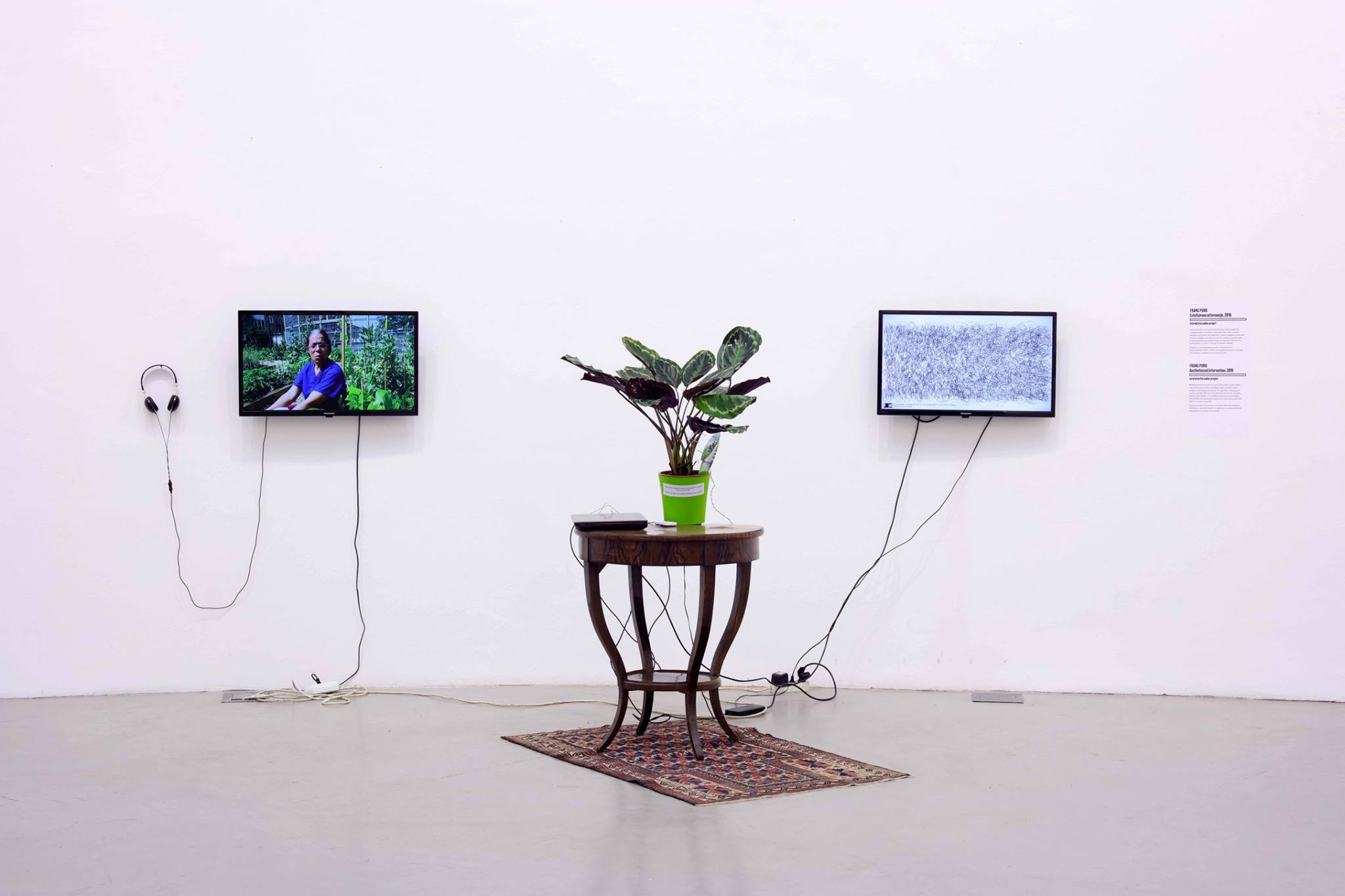
Several months after the razor wire had been put up or, more specifically, a few days before Easter 2016, Slovenian Police representatives suddenly began removing it from the Croatian-Slovenian border and announced that, instead of the wire reminiscent of concentration camps, they would put up a panel fence that would “look more presentable,” and would not kill so-called “wild game.” On International Animal Rights Day, 10 December 2015, members of the activist group Animal Friends Association from Croatia organised an action in a public space to draw attention to these deadly walls, fences, cages and wires that are considered perfectly normal by both the former and current Slovenian and Croatian governments.
Furthermore, in 2015 the Slovenian activist association For Animals! organised a performance against the slow and cruel death of animals in the background of the capitalist division of the country into nation-states. The performance was held on Saturday, from 11 a.m. until 12 p.m., on Maribor’s Main Square. Unlike the Croatian association, the Slovenian one focused on the struggle against the capitalist division among states. The performance also symbolically addressed the racism of Slovenia and the European Union towards migrants. On their leaflets, they stated the following:
The refugee crisis caused by globalisation and the imperialist war of aggression is continuously used as an excuse to increase “security,” i.e. to centralise control of the EU and the deployment of the security forces of repression. The irrationality of the international capitalist order, which divides the world by national law into rich and poor countries, is also reflected in the installation of bladed wire fences. Slovenian government has also rejected refugees with the repressive message: “Stay over there!” The wire fences currently separate more than 1/6 of the Slovenian-Croatian border; since wildlife habitats occupy both territories, the wire fencing limits the established routes of animals. In the attempt to cross territories, many of them are caught in the wire and frequently die in agony or undergo “mercy killing” by hunting rifles. (Vičar, personal correspondence)
The victims have been primarily deer; otherwise, the bladed wire presents a threat to brown bears, wolves, and lynx. They (animals, or non-humans) are freely (naturally) crossing the human state borders that are culturally absurd and take after the hegemonic flag-totems, as aphoristically put by Erich Fromm regarding contemporary political totems.
On 19 March 19 2016, a photograph by Boris Kovačev documenting the horrible fate of a roe deer killed by the razor wire was selected as the photo of the week of the Croatian newspaper Jutarnji list. Željko Ivanjek documented the aforementioned tragic incident on the Hungarian-Croatian border with the following statement: “The higher the fence of the hunter, the greater his fear. His defence implies innocent victims” (Ivanjek 25 [see Pušić 18-19]), thus placing into correlation the metaphor of the hunter with today’s border guards.
Varaždin multimedia artist Ivan Mesek reacted to the above situation of speciesism towards animals in nature, and together, with his colleague Zefrey Throwell, recorded the short film, Woodland Concertina (2016). The artists procured a duck, a rabbit and a pheasant, and took them to the Police Department in order to make them passports. Then they created fake documents for these animals trying to cross the Croatian-Slovenian border. Finally, the artists set the animals free in nature, outside of the zone of the razor-wire fence. The short film Woodland Concertina addresses the issue of animals forcibly being given a nationality in the refugee crisis and the totalitarian praxis of border closing (Mesek 117-118).
In the sense of producing more and more borders despite globalisation, media activist Shuddhabrata Sengupta introduces the term “frontierisation” regarding the urban areas in Europe; despite the alleged erasing of borders within the territories of the European Union, the EU technocracy has divided Europe into zones with different control systems, so as to stop or redirect migrations already in their early phase, but also to condense the control as a whole (Raunig 246, 255).
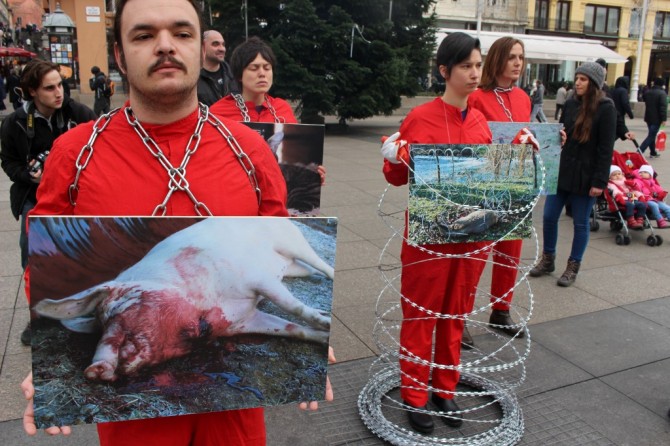
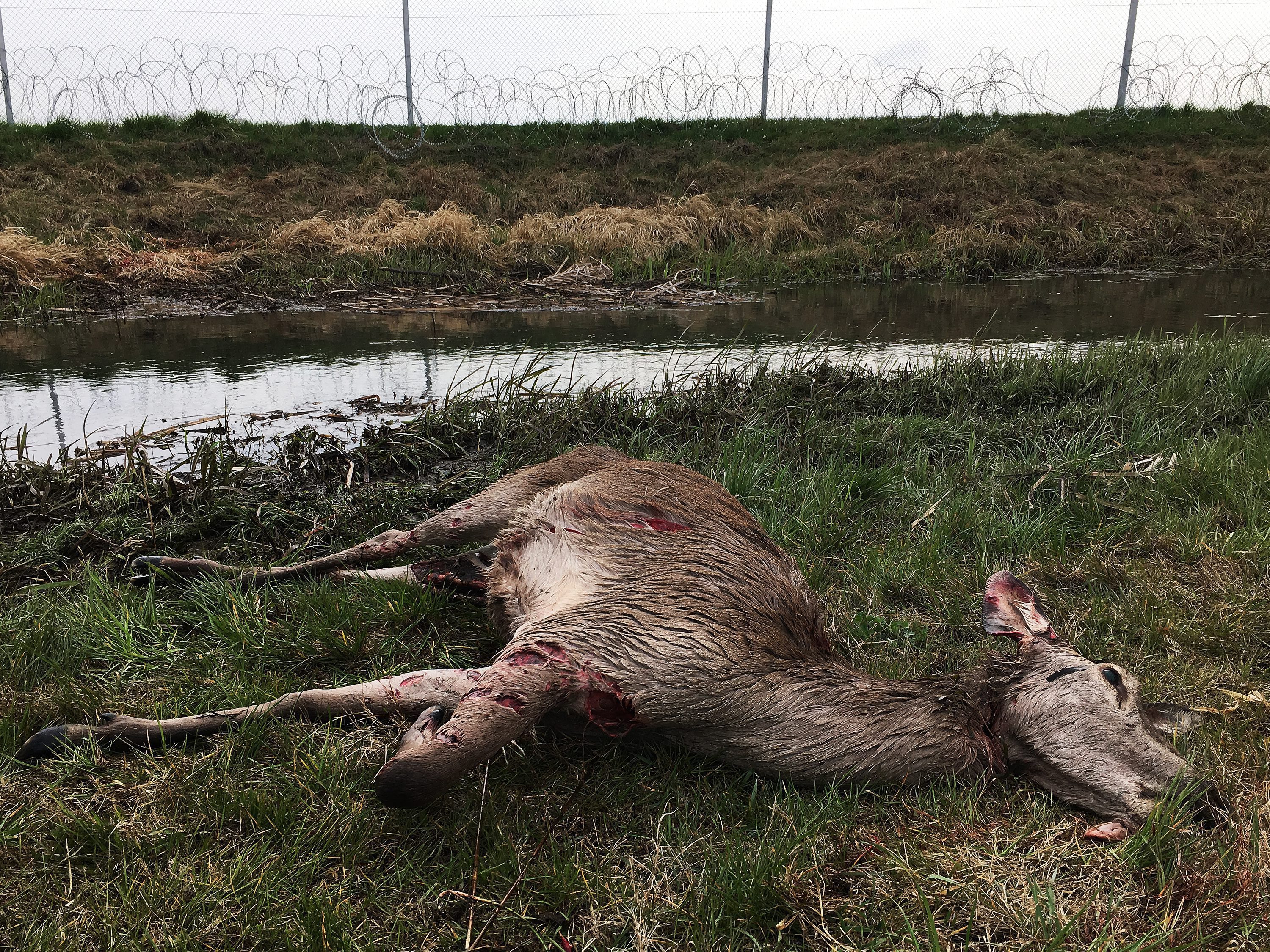
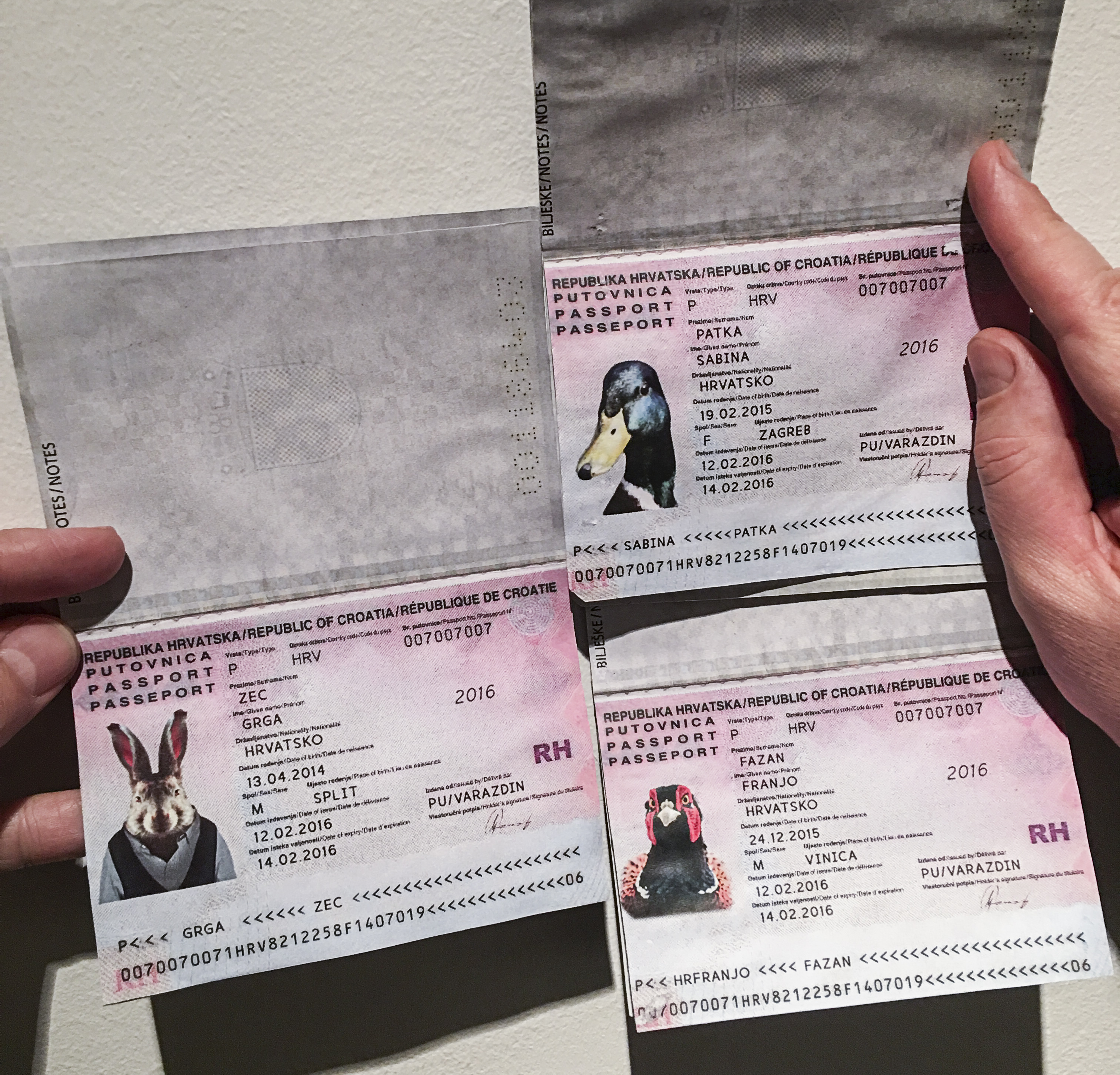
The “shachtophone” performance, Every Revolution is a Throw of the Dice, Except That…(2016)[3] by the House of Extreme Music Theatre — Damir Bartol Indoš and Tanja Vrvilo (Perforations Festival, Zagreb edition, 2016) — also thematises the connection between racism and speciesism.
Prior to the aforementioned interpretation, I would like to contextualise the meaning of the schachtophone. Schachtophones are sound sculptures of different sizes played by performers according to graphic sheet music while standing next to or within the instrument. They are metal sound boxes with a network of springs, and one enters them (with their hand or body) by opening the lids/shafts. Each box has its own surveillance camera, and the image is projected on the outer metal surface of the schachtophone. The instruments are a follow-up to Indoš’s years-long engagement in sound and found objects as the ready-mades of sound. At the beginning of his career (in his Kugla phase, in the 1980s), Indoš produced instruments made of industrial waste (as he calls them — spiritually recycled waste), which also initiated his collaboration with numerous multimedia musicians.[4] The “shachtophone” scene-installation evokes the truck of the Slovak company HYZA in which 59 men, eight women, and four children — all of them being forced immigrants from Syria — recently (in 2016) suffocated while attempting to cross one of European border “walls,” approximately forty kilometres outside of Vienna — within reach of their desired exodus of closed borders, somewhere in Hungary, as reported by some media (see Harding 2015). What the House of Extreme Music Theatre found deeply unsettling, in the ethical sense, was the horrifying coincidence that HYZA had been advertised on Slovak national television with an anti-immigrant racist commercial[5] three months prior to this holocaustic event, the horror of which is unspeakable, i.e. the protagonists of which, to quote Indoš, are evil people (Indoš, personal correspondence). Specifically, the commercial — following the recognisable racist key, a key for opening hatred towards Others, as the Nazis had once paved the way to eradication of Jews by zoomorphically comparing the latter to rats — compares the immigrants to chickens, whereby the immigrant chickens shall be deported by the Slovak system of control and punishment, while only the authentic Slovak chicken/pravé slovenské kurča shall find its way to Slovakia, to the Slovak families, and to the Slovak kitchens. Indoš points out that the horror of this recent holocaust lies in the fact that the aforementioned commercial was effective and was broadcasted daily on Slovak television, polluting the mental space of those who believe in the categories of goodness and open arms, three months prior to the abovementioned suffocation of immigrants, even though — to quote the benevolent Indoš once again — some other evil people rented the truck of said company for the illegal transport of immigrants, out of the bodies of whom they also made profit (Indoš, personal correspondence). Furthermore, Slovakia was the first to cynically proclaim that they would accept only Christians once the distribution strategy among members of the European Union is announced.
On a metal screen (the outer image of the schachtophonic cube), the aforementioned deconstructed commercial was projected, interrupted by the image of schachtophonic springs from the schachtophonesm operated by the performers.
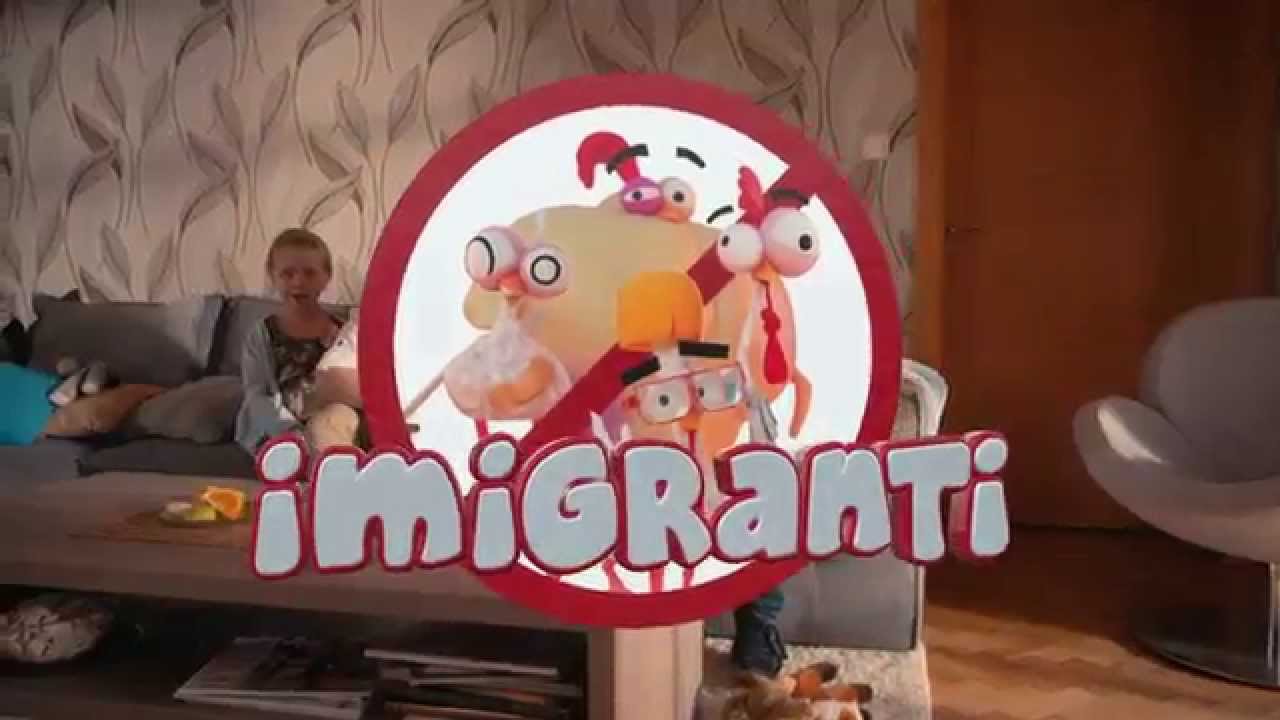
On the track of “challenges to humanism,” Animal Friends Association from Croatia (which I have mentioned in the context of their action against razor wire, with which they addressed for the first time the deaths of animals that are unable to migrate the Croatian-Slovenian and Croatian-Hungarian borders) published in 2005 the Croatian translation of the book Eternal Treblinka: Our Treatment of Animals and the Holocaust (2002) by Charles Patterson, who fundamentally acknowledged the analogy between speciesism and racism. Specifically, regarding the poignant analogy between the Jewish and animal holocaust — as stressed by Helmut Kaplan, one of the leading minds of the animal rights movement — the aforementioned analogy is as politically provocative to speciesists as it is ethically justified.
The terrifying titular syntagm Eternal Treblinka was co-opted by Charles Patterson from the short story The Letter Writer by the Yiddish author Isaac Bashevis Singer or, to quote him directly: “In relation to them (animals), all people are Nazis; for the animals it is an eternal Treblinka” (Patterson 183). Singer was the first to draw attention to the analogy between the Jewish and animal holocaust, concentration death camps, and industrialised slaughterhouses; Patterson identified him as the most empathetic animal advocate in contemporary literature, and dedicated Chapter 7 (entitled This Boundless Slaughterhouse) of his book to the empathetic vision of the aforementioned author, as well as Eternal Treblinka. Briefly put, Patterson systematically demonstrates that a parallel can be drawn between the speciesist and the anti-Semitic (or any other discriminatory) ideology, between the American slaughterhouse model (Porcopolis, the moniker for Cincinnati, America’s first meat-processing centre) and the German concentration camp model. Thereby, as stressed by Patterson, this is not a metaphor (or metaphorical level), but rather an actual connection between the two aforementioned discriminations — discrimination on the basis of race, and that on the basis of species (speciesism).
The roots of speciesism lie in the lack of understanding of discrimination in industrial concentration death camps, as well as in the contemporary global ecocide/Geocide[6] ; on this track, I documented the works of these Croatian artists and their reaction to contemporary speciesism and racism in the context of the refugee/humanitarian crisis of 2016 — naturally, each from their own particular ethos. In her video installation, Resnik (1994), Sanja Iveković thus paralleled the fates of the Muslim refugees at the beginning of the war in Bosnia and Herzegovina, who were placed in a refugee camp near Zagreb, with the lives of plants. While the plants depicted in Iveković’s video installation were left to die, as the artist equalises the lives of plants and asylum seekers, Franc Purg — within the framework of his bioethical piece Aestheticized Information (2016, interactive online project) — collects and documents internet data, including images and text, on the subject of refugees and endangered species. It is a fact that the human civilisation destroys 150-200 plant and animal species per day on average (see Vidal 2010). Furthermore, Animal Friends Association, with their actions, and Ivan Mesek, with his documentary Woodland Concertina (2016), have drawn attention to that which is happening with the so-called wild animals at border crossings due to the razor wires. The “scachtophone” performance, Every Revolution is a Throw of the Dice, Except That…(2016), by D. B. Indoš and Tanja Vrvilo (House of Extreme Music Theatre), deeply and critically demonstrated the aforementioned analogy between racism and speciesism, as documented by Charles Patterson in the chapter “Wolves, Apes, Pigs, Rats, Vermin: Vilifying Others As Animals” in his book Eternal Treblinka.
The equalisation of racism and speciesism (see Patterson 27-50), explicitly demonstrated by the aforementioned Slovak commercial and deconstructed by the performance group House of Extreme Music Theatre in their radical musical performance, serves to testify that the period in which we live borders on fascism or, as stated by the Dutch cultural philosopher Rob Riemen: “Even the re-growing poisonous plant must develop completely before it proceeds to spread its toxin. We are merely at the beginning of contemporary fascism that ought not to be compared to the end of 20thcentury fascism, but rather to its beginning” (9). Along that line, Riemen states that Putin’s Russia has already become a fascist state, as well as Hungary, while the voices of new fascism “can be heard in France, Italy, Denmark, Finland, Croatia, Greece, Romania, Belgium […] and the Netherlands” (9). “The rest is silence,” as Hamlet apprehensively declares.
A Croatian language version of parts of this article was originally published in The Topoi of Performance Art: A Local Perspective (Durieux, HS AICA, 2017).
[1] I co-opted the title of the exhibition (curated by Suzana Marjanić and Marijana Stanić) as a syntagm from the metafictional novella about animal rights The Lives of Animals (1999) by J. M. Coetzee.
[2] Ana Dević and Nataša Ilić highlight the parallelism between refugees and plants in the context of everyday life in a refugee camp, which is best documented by the words drying and dying (Dević, Ilić, http). In other words, as noted by Roxana Marcoci in the catalogue on the occasion of the artist’s exhibition Sweet Violence (2011/12) at MoMA: “In a darkened room, with a video projection as the only source of light, the artist set up differently, mostly human-sized plants. They will either dry out or die over the course of time” (Marcoci, cf. Marjanić, Stanić 2016:81-82, cf. Smith, 2011, http). For the purposes of the 51st Zagreb Salon of Visual Arts, the ethosof the video installation was modified in the name of life.
[3] This “shachtophone” performance is manifestly devoted to Mallarmé’s poem A Throw of the Dice Will Never Abolish Chance (1897).
[4] E.g. multi-instrumentalist, composer and performance artist Elliott Sharp, free jazz musician Charles Gayle, Helge Hinteregger, Emil Krištof, Zlatko Burić (“Kićo”), Henning Frimann, Ivan Marušić (“Klif”), Igor Pavlica, Milan Manojlović, Miro Manojlović, Srđan Sacher, Roy Ashis, Damir Prica Kafka, ex-SexA, Ali Gaggl, etc.
[5] Cf. https://www.youtube.com/watch?v=Sp28kOZW66A
[6] As one of the many, many examples of the recent ecocide, I would like to point out the case of Ontario (Canada) where 37 million bees were found dead after planting a large GMO corn field. Cf. http://dailynativenews.site/2018/03/37-million-bees-found-dead-after-planting-large-gmo-corn-field
Dević, Ana, and Nataša Ilić. “Sanja Iveković.” http://archiv.fridericianum-kassel.de/ausst/balkan03/kuenstler/33.html#english. Accessed 6 June 2016.
Harding, Luke. “Hungarian Police Arrest Driver of Lorry that Had 71 Dead Migrants Inside.” The Guardian. 28 August 2015. https://www.theguardian.com/world/2015/aug/28/more-than-70-dead-austria-migrant-truck-tragedy. Accessed 30 June 2018.
Ivanjek, eljko. “Fotografija tjedna. Boris Kovačev.” Jutarnji list. 19 March 2016, 24-25.
Kershaw, Baz. The Radical in Performance: Between Brecht and Baudrillard. Routledge, 1999.
Lay, Vladimir, Krešimir Kufrin, and Jelena Puđak. Kap preko ruba čaše: klimatske promjene i Hrvatska. Croatian centre “Znanje za okoliš,” 2007.
Marjanić, Suzana. Kronotop hrvatskoga performansa: od Travelera do danas. Bijeli val Association,Institute of Ethnology and Folklore Research, Školska knjiga, 2014.
———. “Vidljivi i nevidljivi logori.” Zarez: dvotjednik za društvena i kulturna pitanja. 13. 12 February 2016, 426-427.
Marjanić, Suzana, and Marijana Stanić. Challenges to Humanism.51stZagreb Salon of Visual Arts/Izazovi humanizmu. 51. zagrebački salon vizualnih umjetnosti. Edited by Suzana Marjanić, Martina Miholić and Marijana Stanić. HDLU, 2016.
Mesek, Ivan. Ivan Mesek. Edited by Branko Franceschi and Ivan Mesek. Zagreb: Museum of Contemporary Art, 2018.
Patterson, Charles. Eternal Treblinka. Our Treatment of Animals and the Holocaust. Lantern Books, 2002.
Petrović, Duško. “Fenomen izbjeglištva u modernom političkom sistemu.” Glasnik Etnografskog instituta SANU. 62:2 (2014). http://www.doiserbia.nb.rs/img/doi/0350-0861/2014/0350-08611402049P.pdf. Accessed 12 June 2018.
Purg, Franc. “Aestheticized Informations.” Interactive online installation. http://francpurg.net/aestheticized_information.html. Accessed 30 June 2018.
Pušić, M. “Stradale stotine životinja, Slovenija dopustila otvaranje više koridora.” Jutarnji list. 24, 25 and 26 December 2016, 18-19.
Raunig, Gerald. Art and Revolution. Transversal Activism in the Long Twentieth Century. Semiotext(e), 2007.
Riemen, Rob. Vječiti povratak fašizma. Second Edition. TIM press, 2015.
Vidal, John. “UN Environment Programme: 200 Species Extinct Every Day, Unlike Anything Since Dinosaurs Disappeared 65 Million Years Ago.” Huffington Post, 17 August 2010. https://www.huffingtonpost.com/2010/08/17/un-environment-programme-_n_684562.html. Accessed June 30 2018.